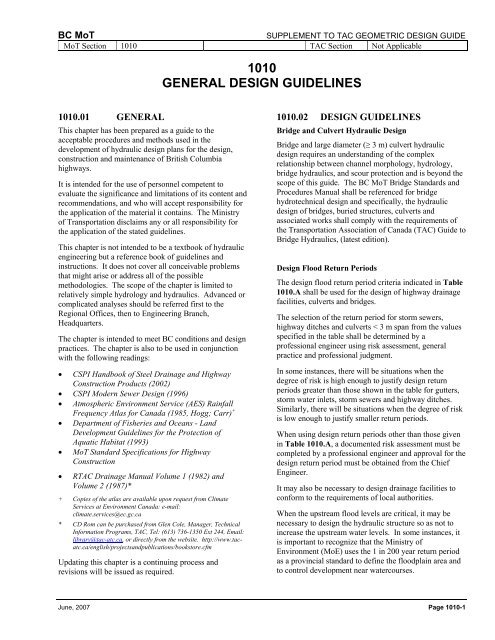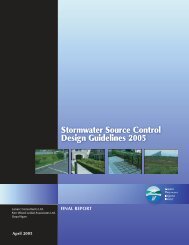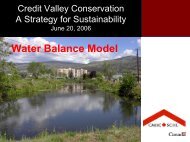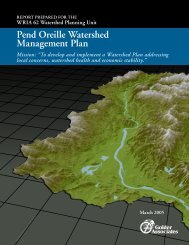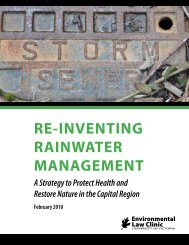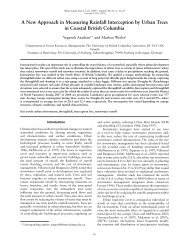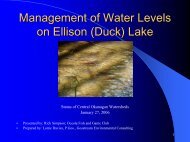1000 Hydraulics Chapter - Ministry of Transportation
1000 Hydraulics Chapter - Ministry of Transportation
1000 Hydraulics Chapter - Ministry of Transportation
You also want an ePaper? Increase the reach of your titles
YUMPU automatically turns print PDFs into web optimized ePapers that Google loves.
BC MoT<br />
SUPPLEMENT TO TAC GEOMETRIC DESIGN GUIDE<br />
MoT Section 1010 TAC Section Not Applicable<br />
1010<br />
GENERAL DESIGN GUIDELINES<br />
1010.01 GENERAL<br />
This chapter has been prepared as a guide to the<br />
acceptable procedures and methods used in the<br />
development <strong>of</strong> hydraulic design plans for the design,<br />
construction and maintenance <strong>of</strong> British Columbia<br />
highways.<br />
It is intended for the use <strong>of</strong> personnel competent to<br />
evaluate the significance and limitations <strong>of</strong> its content and<br />
recommendations, and who will accept responsibility for<br />
the application <strong>of</strong> the material it contains. The <strong>Ministry</strong><br />
<strong>of</strong> <strong>Transportation</strong> disclaims any or all responsibility for<br />
the application <strong>of</strong> the stated guidelines.<br />
This chapter is not intended to be a textbook <strong>of</strong> hydraulic<br />
engineering but a reference book <strong>of</strong> guidelines and<br />
instructions. It does not cover all conceivable problems<br />
that might arise or address all <strong>of</strong> the possible<br />
methodologies. The scope <strong>of</strong> the chapter is limited to<br />
relatively simple hydrology and hydraulics. Advanced or<br />
complicated analyses should be referred first to the<br />
Regional Offices, then to Engineering Branch,<br />
Headquarters.<br />
The chapter is intended to meet BC conditions and design<br />
practices. The chapter is also to be used in conjunction<br />
with the following readings:<br />
• CSPI Handbook <strong>of</strong> Steel Drainage and Highway<br />
Construction Products (2002)<br />
• CSPI Modern Sewer Design (1996)<br />
• Atmospheric Environment Service (AES) Rainfall<br />
Frequency Atlas for Canada (1985, Hogg; Carr) +<br />
• Department <strong>of</strong> Fisheries and Oceans - Land<br />
Development Guidelines for the Protection <strong>of</strong><br />
Aquatic Habitat (1993)<br />
• MoT Standard Specifications for Highway<br />
Construction<br />
• RTAC Drainage Manual Volume 1 (1982) and<br />
Volume 2 (1987)*<br />
+ Copies <strong>of</strong> the atlas are available upon request from Climate<br />
Services at Environment Canada: e-mail:<br />
climate.services@ec.gc.ca<br />
* CD Rom can be purchased from Glen Cole, Manager, Technical<br />
Information Programs, TAC, Tel: (613) 736-1350 Ext 244, Email:<br />
library@tac-atc.ca, or directly from the website. http://www.tacatc.ca/english/projectsandpublications/bookstore.cfm<br />
Updating this chapter is a continuing process and<br />
revisions will be issued as required.<br />
1010.02 DESIGN GUIDELINES<br />
Bridge and Culvert Hydraulic Design<br />
Bridge and large diameter (≥ 3 m) culvert hydraulic<br />
design requires an understanding <strong>of</strong> the complex<br />
relationship between channel morphology, hydrology,<br />
bridge hydraulics, and scour protection and is beyond the<br />
scope <strong>of</strong> this guide. The BC MoT Bridge Standards and<br />
Procedures Manual shall be referenced for bridge<br />
hydrotechnical design and specifically, the hydraulic<br />
design <strong>of</strong> bridges, buried structures, culverts and<br />
associated works shall comply with the requirements <strong>of</strong><br />
the <strong>Transportation</strong> Association <strong>of</strong> Canada (TAC) Guide to<br />
Bridge <strong>Hydraulics</strong>, (latest edition).<br />
Design Flood Return Periods<br />
The design flood return period criteria indicated in Table<br />
1010.A shall be used for the design <strong>of</strong> highway drainage<br />
facilities, culverts and bridges.<br />
The selection <strong>of</strong> the return period for storm sewers,<br />
highway ditches and culverts < 3 m span from the values<br />
specified in the table shall be determined by a<br />
pr<strong>of</strong>essional engineer using risk assessment, general<br />
practice and pr<strong>of</strong>essional judgment.<br />
In some instances, there will be situations when the<br />
degree <strong>of</strong> risk is high enough to justify design return<br />
periods greater than those shown in the table for gutters,<br />
storm water inlets, storm sewers and highway ditches.<br />
Similarly, there will be situations when the degree <strong>of</strong> risk<br />
is low enough to justify smaller return periods.<br />
When using design return periods other than those given<br />
in Table 1010.A, a documented risk assessment must be<br />
completed by a pr<strong>of</strong>essional engineer and approval for the<br />
design return period must be obtained from the Chief<br />
Engineer.<br />
It may also be necessary to design drainage facilities to<br />
conform to the requirements <strong>of</strong> local authorities.<br />
When the upstream flood levels are critical, it may be<br />
necessary to design the hydraulic structure so as not to<br />
increase the upstream water levels. In some instances, it<br />
is important to recognize that the <strong>Ministry</strong> <strong>of</strong><br />
Environment (MoE) uses the 1 in 200 year return period<br />
as a provincial standard to define the floodplain area and<br />
to control development near watercourses.<br />
June, 2007 Page 1010-1


